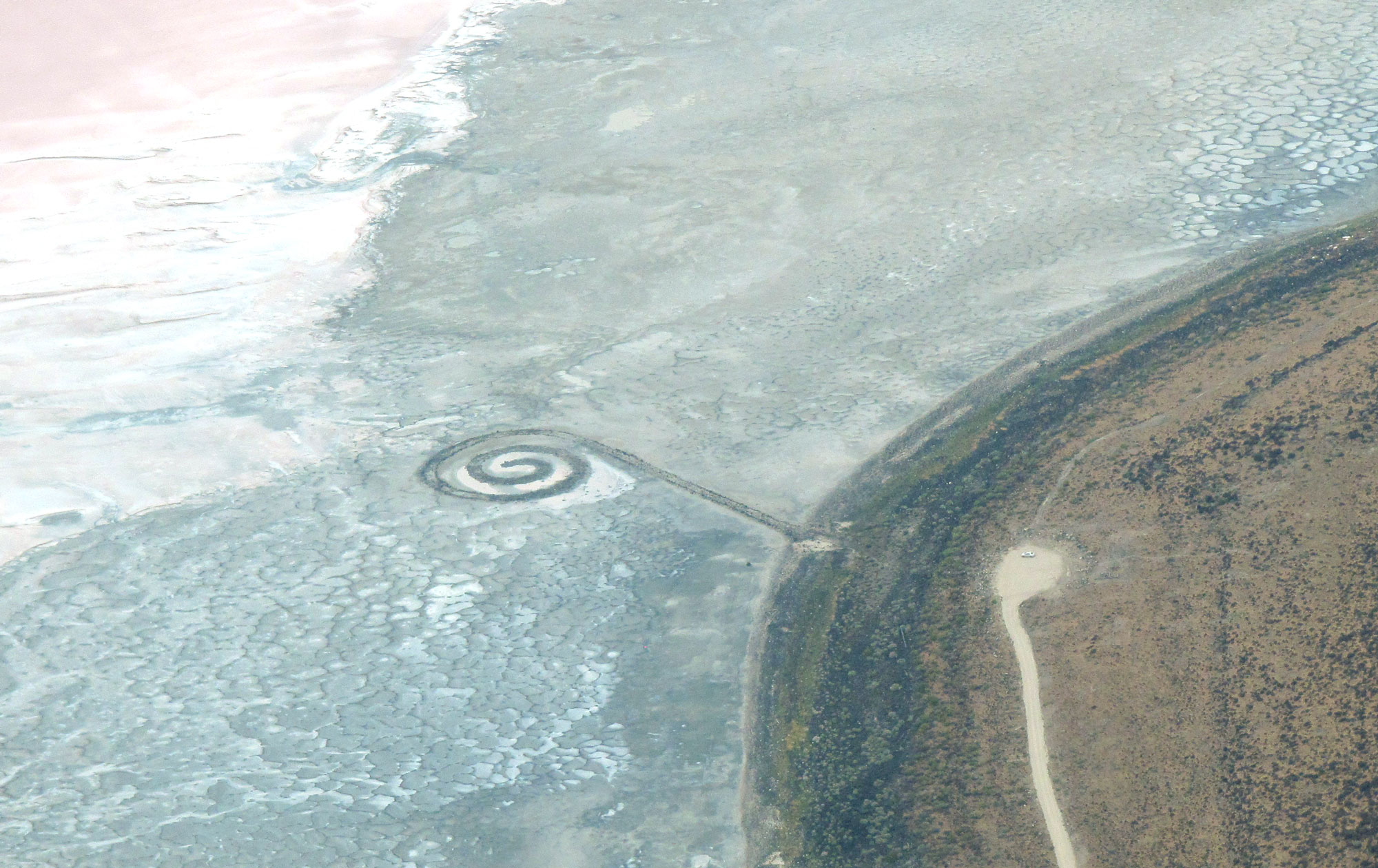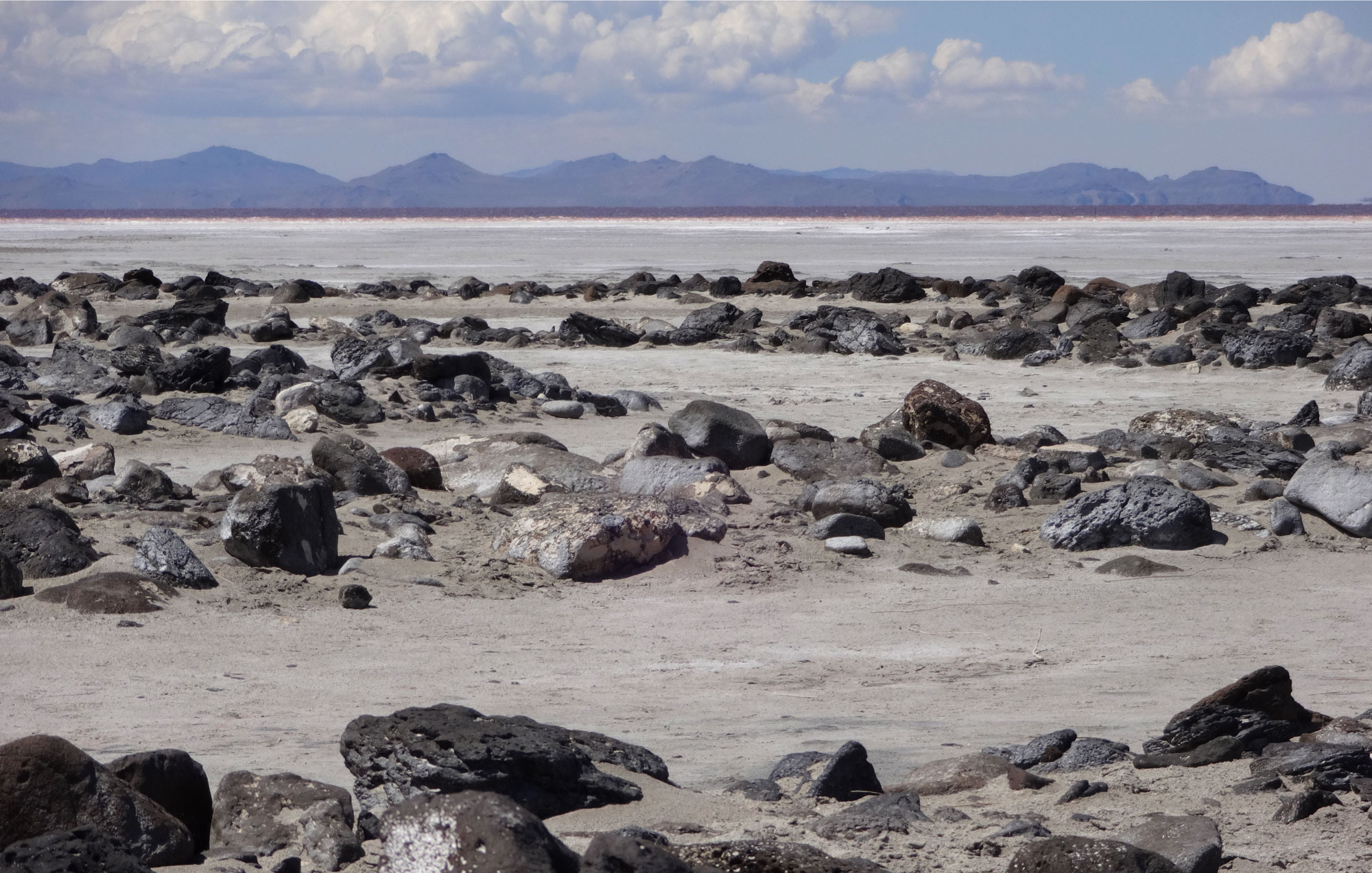
One of the most renowned works of land art, Robert Smithson’s Spiral Jetty embodies considerations that share affinities with what will later be found in the philosophy of Gilles Deleuze. Reflecting on notions such as tension and scale, Andrea Mubi Brighenti traces how the spiral’s stone, salt and mud produce an intensive state which sits at the threshold between dissolution and becoming, between one configuration and another.
If there ever was a geophilosopher before Gilles Deleuze, it was certainly Robert Smithson, the prematurely deceased artist and critic who, since the mid-1960s and through the early 1970s, explored the American land with a keen eye for natural history, industrial ruins, suburban civilisation, rock strata and salt crystals. He called his art, “earthworks.” After temporarily withdrawing from the art world, thereby breaking with his earlier religious-metaphysical Angst, Smithson resumed work as the child he had been, extraordinarily excited by natural history, geology and art history, but also as a new powerful theorist of the environment and the role of art in an ecological world.
Smithson probed territories of new consistence, sampling their strata, drawing new continental maps of them, composing spatial and temporal scales of a completely new conception. He suggested, for instance, that concrete dams and drainage pipes could be regarded as giant sculptures; that an airport could be developed as a crystalline lattice extending over the ground as well as suspended in the air, a landscape in which aircrafts would feature as “temporary buildings;” that removing the mud from the ponds in Central Park could be treated in terms of “mud extraction sculpture;” that elements such as “pavements, holes, trenches, mounds, heaps, paths, ditches, roads, terraces” could all bear aesthetic significance. “Size – Smithson famously claimed – determines an object, but scale determines art.” He thus advanced a notion of scale that fundamentally operates on the basis of an uncertainty principle analogous to the one that founds quantum physics and the study of natural symmetry breaking processes. A whole philosophy of asymmetrical becoming (one which we would usually call, “Deleuzian”) is entailed: “One seizes the spiral, and the spiral becomes seizure.”
Spiral Jetty is, in fact, one of Smithson’s most renown pieces. Less known, perhaps, is that the homonymous text, dating from 1972, richly documents not only his driving inspiration and guiding philosophy, but also his chorographic search for the artwork site (finally found in the proximity of Rozel Point on the Great Salt Lake) as well as the arrangements with the construction company in charge of transporting and bulldozing the earth for such an uncanny pier. The main technical difficulty, we learn, derived from keeping the spiral together with so much soft mud threatening to melt it away. It is precisely out of such a close engagement with materials that a fine detection of territorial intensities could arise. Smithson’s initial driver was the water’s red hue characterising some sections of the lake. Far from being an arbitrary or capricious choice conceived by a New York artist in his fancy studio, the colour red speaks directly of geological ages and biological processes: “Chemically speaking, our blood is analogous in composition to the primordial seas.” The trip to Utah can in this sense be described as, simultaneously, a geographic survey, a geological expedition, a land rights acquisition operation, a twisted Arcadian-American dream (“Et in Utah ego”), an artist residence, and most importantly, a cosmic realisation: “Irregular beds of limestone dip gently eastward, massive deposits of black basalt are broken over the peninsula, giving the region a shattered appearance.”
As a new perception arises, sensitivity to the environment becomes pivotal. Only an accomplished territoriologist can grapple with the experience of intensity – the way researchers as disparate as Aby Warburg, Walter Benjamin, Michel Leiris, Andrei Tarkovsky, and Boards of Canada did. The recording of the environment’s “roundness” and the approximation of the umbilical element in the extreme heat of the desert, upon a suspended temporal threshold, coalesce at the site chosen by Smithson. Mathematically, spirals are based on surd (irrational) numbers. For Smithson, it is precisely such a “surd state” that mirrors the indeterminate situation grounding Spiral Jetty: “the surd takes over and leads one into a world that cannot be expressed by number or rationality. Ambiguities are admitted rather than rejected, contradictions are increased rather than decreased – the alogos undermines the logos. Purity is put in jeopardy.”

Robert Smithson’s Spiral Jetty by Retis is licensed under CC BY-NC 2.0
For their part, with books such as A Thousand Plateaus (1980) and What is Philosophy? (1991), Deleuze and Guattari sought to develop the project of a philosophy of nature within a horizon of immanence, without resort to pure transcendent types and forms of the Platonist tradition. Their project displaces philosophy from the activities of contemplation, critical reflection, or communication, and turns into a “geophilosophy,” where the adventure of thought is fashioned as thoroughly territorial, imbued with the interactions of local and cosmic forces. The formative privilege of the transcendental subject of the Kantian tradition vanishes when one realises that forms are established with earthly energies always on the verge of chaos, and that thinking “only” means to evoke new lands to come. Deleuzian becoming differs from imitation because it has eliminated fixed models: the imitated object changes no less than the imitating subject in function of a whole environmental, experimental composition. A geophilosophy is a territoriology in which trajectories across territories are bound to encounter and, in turn, generate intensive states. A Thousand Plateaus states: “Every voyage is intensive, and occurs in relation to thresholds of intensity between which it evolves or that it crosses.”
By the time Deleuze and Guattari wrote these lines, Smithson had already perished in an aeroplane crash near Amarillo, Texas, while surveying the site for his forthcoming Ramp work. He was aged 38. With reference to the making of Spiral Jetty, Smithson had critically remarked: “One could only hope that tension would hold the entire jetty together, and it did.” Surely, tension is one of the possible manifestations of the more general phenomenon of intensity. And Smithson’s trip in intensity through earth-bound tension defines the consistence of an oeuvre that can be appreciated as an exploration of territorial thresholds, whose “quadratic space” – as algebraic topologist René Thom called the resolution map of a coordinate space – still awaits adequate mapping.
It has been observed that the generation of artists from the 1960s and 1970s, even when ecologically aware, had no clue of climate change and the actual magnitude of man-made environmental disaster. It can be conceded that the majority were still living in the ideological waters of modernist optimism towards the alleged technological mastery of the world (if not the universe). Nonetheless, if there is a message from them that still resonates in the 2010s and 2020s, then perhaps it lies in their fostering of the realisation that the entanglement of humans and nature could not – and still cannot – be disentangled by any idyllic escapist dream.
Smithson was particularly harsh in his assessment of the “spiritualist” discourse that animates classic environmentalism of conservationist type, dubbing it snobbish. He pointed out that the artist cannot escape the evil – including, environmental evil: “The authentic artist cannot turn his back on the contradictions that inhabit our landscape.” With hindsight, we have learnt, not simply that any aesthetic retreat into paradise is impossible, but that escape (including, for instance, withdrawing in air-conditioned bubbles of environmental comfort, in tax havens, and in ghettos for the rich) is part of the problem, not of the solution. New measures for composing coexisting humans and natures – natures that are urban, suburban, compromised, hybrid, bastardised, even irreversibly polluted – are badly needed to avoid utter catastrophe. If humans are a geological force (as encapsulated in the term “Anthropocene”), it is not because they are stronger than nature, but because they carry in themselves a force that is stronger than them. It is necessarily out of the hubris – and the debris – of modernism that a new modesty for our troubled times must emerge.
Recent articles

Southern California is many things. Quite infamously, it is known as a landscape defined by the automobile, from the emergence and diffusion of the highway system to fast food burgers, and the suburbanization of the United States. Walking this place then, would seem not only inconvenient, but ill advised. In… Read more »

What is today known as ‘whistleblowing’ could once take the form of interacting with a threatening gaze carved into the city wall. It is the case of the ‘boche de Leon’ or ‘lion’s mouths’ disseminated by the old Venetian Republic throughout its territory to suppress illegal activities. Through a close… Read more »

As he navigates through the recurrent lockdowns of the pandemic, stranded between hitchiking and muggings, job hunting and separations, Fabio Valerio Tibollo rediscovers photography as a powerful coping mechanism. Recording everything that happened around him for one year straight, from attending momentous events to finding curiosity in shots of simple living,… Read more »

